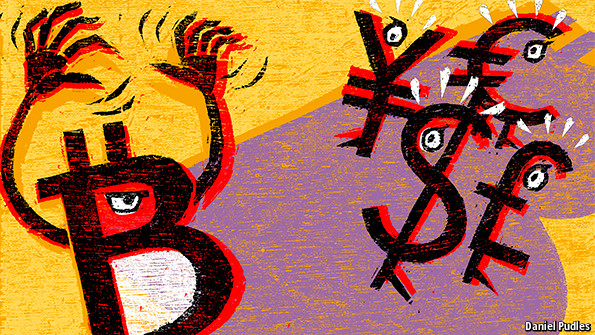The rise and fall of the crypto-currency is good news for authors at least
BITCOIN may well be the world’s worst-performing currency. In 2014 it lost more than half of its value against the dollar, beating even Ukraine’s hryvnia and the Russian rouble. But measured by the number of new books it has inspired, bitcoin is top of the pile. Nearly 200 titles about the crypto-currency came out last year, according to Amazon. Another dozen will hit the shelves in the coming months.
Be warned, though, some are pretty bad. Brian Kelly, an investment manager and talking head on CNBC, takes several stabs in “The Bitcoin Big Bang” at explaining how the crypto-currency works, only to confuse the reader with his odd metaphors: “Let’s call the first bitcoin a socialite named Genesis.” Dominic Frisby is a comedian and a financial writer who in an earlier book outed himself as an anarcho-capitalist. In “Bitcoin: The Future of Money?” he suggests that bitcoin will change the world as we know it because governments will be unable to raise money for long wars if the currency is widely adopted. “It is a force for peace,” Mr Frisby insists.
For any book on bitcoin to be worth reading, though, it has to delve further: into the crypto-currency’s ideological and technical roots, for instance, or what it adds to the narrative of money, or even what its economic and political impact may be. The currency’s dollar price may be three-quarters down on its peak, but the underlying technology also provides plenty of intellectual fodder—and is unlikely to go away. So there is plenty to write about if you are serious.
Paul Vigna and Michael Casey, two journalists at the Wall Street Journal, are certainly serious. In their new book, “The Age of Cryptocurrency”, they don’t waste time projecting millenarian political beliefs or searching for bitcoin’s elusive creator, Satoshi Nakamoto, though they argue that the crypto-currency’s quasi-religious “creation myth” has been an important factor in creating a community around the project. Before he went offline in 2011 without leaving much of a trail, Mr Nakamoto had cleverly combined ideas developed by others with his main invention: the “blockchain”, a public ledger of all bitcoin transactions. The blockchain lives on the system’s global network and is maintained and protected by “miners”, operators of specialised computers who are rewarded with bitcoin for their efforts.
Rather than begin their book with a breathless account of how bitcoin could change everything, Messrs Vigna and Casey start with a brief account of the centuries-old debate about the nature of money. The “metallist” school sees money as a commodity, a thing with its own inherent value—which governments should leave alone as much as possible. By contrast, “chartalists” view money as a complex system of credit relationships, which allows value to flow within a society. For these people currency is just the token around which the monetary system is arranged. And governments have a role to play in managing this system and thus the economy.
This philosophical division is also present in the debate about bitcoin. Libertarians treat it as a scarce commodity that needs to be “mined” (to create bitcoin and maintain the blockchain, miners solve mathematical puzzles, meaning that bitcoin is willed into existence by burning energy—see article). But for a growing number of geeks and venture capitalists bitcoin is less a currency than a technology that can be used to transfer money and other assets cheaply and securely.
Messrs Vigna and Casey predict that bitcoin’s main calling will indeed be as a disruptive payment system. Before the crypto-currency, societies had to rely on banks and other centralised institutions to keep track of payments and guarantee the financial system. This position as gatekeeper has allowed these institutions to capture much economic rent. The blockchain technology cuts away the middlemen by taking over the role of ledger-keeping. “At its core, crypto-currency is not about the ups and downs of the digital currency market,” the authors write, but “about freeing people from the tyranny of centralised trust.”
The book is at its liveliest when it discusses the potential impact of bitcoin. The currency may not be a must-use in rich countries with well-developed payment services, but it could help the poor world’s 2.5 billion unbanked to connect to the formal financial system (the book opens with the story of an Afghan woman who gets paid in bitcoin for the articles she writes for an American website). What is more, because no one controls the blockchain it has already become the foundation (“platform” in the parlance) for a growing number of start-ups. And the technology may also undermine other centralised institutions in the “trust business”, such as stockmarkets, or give the sharing economy a boost (some have speculated that in future taxis may be not only self-driving, but self-owned—meaning they are effectively owned by the blockchain).
Wisely Messrs Vigna and Casey do not predict that this will happen overnight, or that the technology is a panacea. Bitcoin and other crypto-currencies will continue to grow, they write, not alongside the offline world, but attached to it, with institutions and businesses adopting it to suit their needs. Bitcoin may well trigger a revolution, but it will be a slow one.
Click on the bitcoin logo below to buy, use or accept bitcoin. Unocoin is India’s most popular bitcoin wallet.
To read the bitcoin white paper, visit: https://bitcoin.org/bitcoin.pdf








